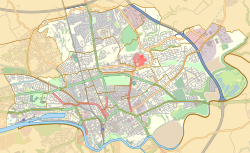St Andrew's Church, Ashton-on-Ribble
| St Andrew's Church, Ashton-on-Ribble |
|
|---|---|

Steeple of St Andrew's
|
|
| Coordinates: 53°46′08″N 2°44′10″W / 53.7689°N 2.7360°W | |
| OS grid reference | SD 516 305 |
| Location | Blackpool Road, Ashton-on-Ribble, Preston, Lancashire |
| Country | England |
| Denomination | Anglican |
| Churchmanship | Evangelical |
| Website | www.standrewsashton.org.uk |
| History | |
| Dedication | Saint Andrew |
| Architecture | |
| Status | Parish church |
| Functional status | Active |
| Heritage designation | Grade II |
| Designated | 27 September 1979 |
| Architect(s) | Ewan Christian (expansion) |
| Architectural type | Church |
| Style | Romanesque Revival, Gothic Revival |
| Groundbreaking | 1835 |
| Completed | 1902 |
| Specifications | |
| Materials | Sandstone, slate roofs |
| Administration | |
| Parish | St Andrew, Ashton-on-Ribble |
| Deanery | Preston |
| Archdeaconry | Lancaster |
| Diocese | Blackburn |
| Province | York |
| Clergy | |
| Minister(s) | Revd James D. G. Nash |
| Laity | |
| Reader(s) | Dr. Brian Hitchen |
| Churchwarden(s) | Dr. Brian Hitchen, Mrs Christine Tognarelli |
| Parish administrator | Mrs Janet Nash |
St Andrew's Church is in Blackpool Road, Ashton-on-Ribble, Preston, Lancashire, England. It is an active Anglican parish church in the deanery of Preston, the archdeaconry of Lancaster, and the diocese of Blackburn. Its benefice is united with that of St Michael and All Angels, Ashton-on-Ribble. The church is recorded in the National Heritage List for England as a designated Grade II listed building.
The foundation stone of the church was laid on 20 August 1835, and the church was consecrated on 7 October 1836 by the Rt Revd John Bird Sumner, bishop of Chester. At this time the church seated about 300 people. In 1873–74 the architect Ewan Christian added a north aisle and converted the nave windows into Early English style. A vestry was added in 1902.
The church is constructed in sandstone with slate roofs. Its plan consists of a four-bay nave, a wide north aisle, a north porch, a chancel with an organ chamber to the north, a vestry to the east, and a small west tower. The tower is in Romanesque style, and the rest of the church is in Early English style. The tower is in three stages, with buttresses, and a short broach spire. In the bottom stage are two round-headed lancet windows, with a similar but larger window in the middle stage. The bell openings are louvred, and consist of triple round-headed lancets. Along the sides of the nave and the aisle are three two-light windows, and a three-light window in the eastern bay.
...
Wikipedia

